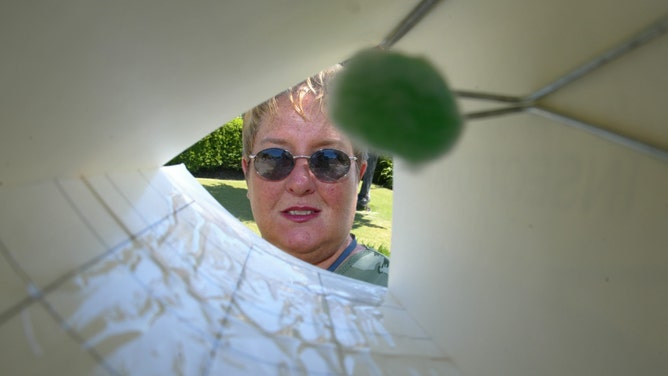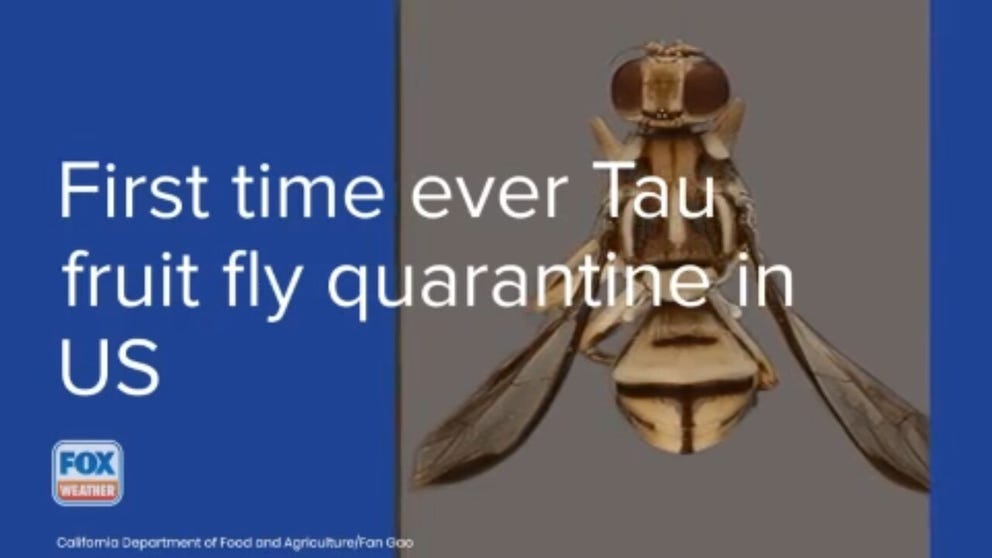Invasive fruit fly spotted in California prompts Northern Hemisphere's first quarantine for insect
Authorities are worried a fruit fly native to Asia could find its way to California's Central Valley, where 40% of the nation's fruits, nuts and other table food is grown.
California: First quarantine in Northern Hemisphere for Tau fruit fly
Inspectors found 20 invasive Tau fruit flies in Los Angeles County. The exotic natives of Southeast Asia threatens California's multi-billion dollar fruit production industry. The state grows about half of what American's eat.
STEVENSON RANCH, Calif. – The California Department of Food and Agriculture placed part of Los Angeles County under quarantine for the invasive Tau fruit fly. This is the first-ever quarantine in the Northern Hemisphere for this insect.
The impacted 79 square miles are in Stevenson Ranch, a suburb about 30 miles northwest of downtown Los Angeles. The community is just 90 miles from the Central Valley, which grows 40% of the nation's fruits, nuts and other table food, according to the U.S. Geological Survey. The more than 250 different crops are valued at $17 billion a year. Nearly half of U.S.-grown fruits, nuts and vegetables come from California.
The quarantined area is the southeast corner of unincorporated Stevenson Ranch, stretching across the freeway.
INVASIVE PEST READY TO SWARM AND EAT ITS WAY ACROSS AMERICA
"The fly is native to Asia and is a serious pest for agriculture and natural resources, with a very wide host range, including numerous fruits and vegetables as well as a select range of native plants in California," the CDFA said in a statement.
The adult female fruit fly lays eggs in fruit. The larvae then tunnel through and feed on the fruit, creating an exit hole, according to the CDFA. A single female can lay up to 400 eggs in her lifetime. Eggs hatch in one to two days. The larvae develop in as little as a week and then drop to the ground. A week later, adults emerge and are sexually mature. Breeding is year-round.
The quarter-inch-long fly is similar in length to a housefly but has yellow and black markings.
Officials identified 34 plants that the fly targets, including tomatoes, citrus avocado, peppers and melons. Tomatoes are one of the top 10 revenue-producing agricultural products for the state.
"Fruit that has been attacked may be unfit for consumption due to this damage and as a result of decay-producing organisms that enter, leaving the interior of the fruit a rotten mass," the CDFA website stated.

Stevenson Ranch is suburban surrounded by green space and wildlands.
(Brian Vander Brug/Los Angeles Times / Getty Images)
Inspectors believe that a traveler brought an infected fruit into the state to start a colony. So far, 20 flies have been discovered.
"To prevent the spread of this invasive species, residents living in the quarantine area are urged not to move any fruits and vegetables from their property," officials said in the statement. "They may be consumed or processed (i.e. juiced, frozen, cooked, or ground in the garbage disposal) at the property where they were picked. Otherwise, they should be disposed of by double-bagging in plastic and placing the bags in a bin specifically for garbage."
TOXIC CANE TOADS SUCCESSFULLY INVADED AND ARE KILLING PETS AND WILDLIFE ACROSS FLORIDA

File: A trapper looks through an Oriental fruit fly trap similar to those that will be set for the Tau fruit fly.
(Stephen Osman/Los Angeles Times / Getty Images)
This is the fourth time inspectors found the Tau fruit fly in the state. The first discovery was in 2016 in neighboring San Bernardino County. Each time the pest was eliminated.
The CDFA, the state's agricultural commissioner and the U.S. Food and Drug Administration are working together to inspect fruit near the detection sites and treat plants with a "naturally derived, organic-approved" insecticide targeting adults. Crews will also use traps with a pheromone lure for adults.
